Top 15 Fascinating Facts About the Moon
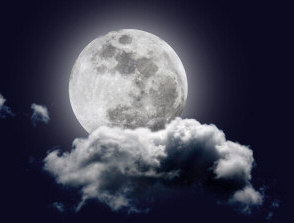 One of the most interesting things about Earth (apart from the fact that it's
so far the only planet known to harbor life on its surface) is its sole natural
satellite - the moon. The earth has one moon, named the Moon, and it hangs in the sky every night and
can sometimes be seen even
during the day. It has fired up imaginations for thousands of years and is featured
prominently in mythology, religion, and literary fiction from all nations throughout the
world. The culmination of human interest in the Moon came in 1969, as Apollo 8
touched down on the harsh surface of the Moon, making it the first and, to date,
the only extraterrestrial object visited by humanity. However, despite the fact
that it was seen, recorded, and samples of it analyzed Earth-side, there are
plenty of fascinating facts that aren't common knowledge. One of the most interesting things about Earth (apart from the fact that it's
so far the only planet known to harbor life on its surface) is its sole natural
satellite - the moon. The earth has one moon, named the Moon, and it hangs in the sky every night and
can sometimes be seen even
during the day. It has fired up imaginations for thousands of years and is featured
prominently in mythology, religion, and literary fiction from all nations throughout the
world. The culmination of human interest in the Moon came in 1969, as Apollo 8
touched down on the harsh surface of the Moon, making it the first and, to date,
the only extraterrestrial object visited by humanity. However, despite the fact
that it was seen, recorded, and samples of it analyzed Earth-side, there are
plenty of fascinating facts that aren't common knowledge.
15) The Moon is Actually Named "The Moon"
Although it has gone by a few other names in fiction, most often Luna, the
proper name for Earth's moon is, well, the Moon. This stands in marked contrast
to natural satellites of other celestial bodies in the solar system. For
example, Jupiter's moons bear names derived from Greek and Roman mythology, such
as Io, Titan, or Europa, all of which have a size similar to that of the Moon.
This isn't a situation exclusive to the English language either. Other languages
also use their equivalents of the generic term “moon” to refer to Earth's sole
natural satellite.
Do You Wish to Travel to the Dark Side of the Moon?
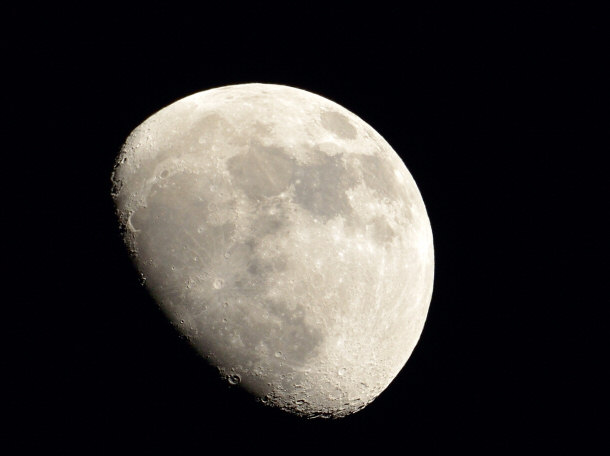
However, many of these languages also use adjectives formed on the basis of
the core word to describe moon-related things. The situation in English is more
complicated, as there are two principal adjectives that relate to the moon. The
first, lunar, is derived from the Latin term for the Moon, Luna, and is the most
commonly used adjective. The other adjective is derived from the ancient Greek
word Selene, and is usually found in a more scientific context, for example, to
describe the geography of the moon. This is known as selenography, a portmanteau
of seleno- and -graphy.
14) It's the Largest Moon in the System (Relatively Speaking)
In absolute values the massive moons of Jupiter take the cake when
it comes to size, with the largest being Ganymede. The earth's Moon is the largest moon
in the solar system relative to the planet it orbits. The Moon's diameter is 27
percent of that of Earth, and having 60 percent of its density. This is one of
its most distinguishing features; one which has also resulted in it gaining such
clear prominence in culture. The bright silver disk entering the sky would be
neither bright nor large if it wasn't for its size. It should be noted that
while the moon seems to be round and spherical, it is neither. The closest
approximation is the shape of an egg, unnoticeable since the Moon always faces
the Earth with the tip towards it.
Jupiter and Some of The Largest Moons in The Solar System

In fiction, the large size of the Earth's moon has been an important plot
point, most importantly in Isaac Asimov's seminal Foundation series. Thousands
of years after the settlement of the Milky Way Galaxy, Councilman Golan Trevize
and historian Janov Pelorat set out to find Earth to find answers to the
questions plaguing the councilman. The original planet of the human species has
been lost in the tides of time, with very few clues available. The unusually
large moon is one of these clues.
13) On the Moon, You'd Weigh a Fraction of What You Do on Earth
It seems obvious, but it is important to note that the gravity on the Moon is
not like it is on Earth. On the contrary, the gravitational pull of Earth's
natural satellite is much weaker than that of its host planet. The gravity on
the surface of the Moon is equivalent to 16.7 percent of that on Earth's
surface. Since weight is tied to gravity, that means you'd weigh just about one
sixth of what you do on Earth if you were walking on the Moon. It has to be
noted that this is not uniform across the entire surface of the Moon. The pull
of the satellite varies depending on location, with local anomalies present in
the larger impact basins. These have to be factored into spaceflights. So much
so, in fact, that they caused problems for early lunar missions since these
anomalies were unknown then.
Imagine Only Weighing About 1/6 of What You Would Back on the
Earth
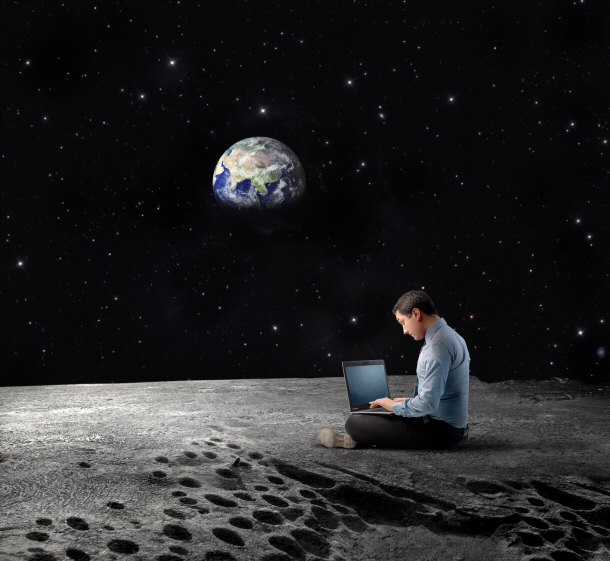
Apart from positively affecting self-image, the low gravitational pull of the
Moon has other benefits. Since the gravitational pull is only a fraction of that
on Earth, spacecraft can lift off its surface much more easily than from the Earth.
Furthermore, the lack of atmosphere means that there is no drag to speak of,
greatly increasing efficiency and decreasing the amount of energy required to
break lunar obit. Although it is no more than a curiosity now, this
could become extremely important in the future, as it would allow for the Moon
to become a transit station between Earth and the rest of the solar system.
12) The Moon is Behind the Tides
The most commonly known effect of the Moon's gravitational pull manifests in
the form of ocean tides. As the Earth spins more than 25 times faster than the
Moon moves around it, the pull of the satellite is dragged along the Earth's
surface faster, and this creates ocean tides. This is not to say that the Moon
is the only factor affecting ocean tides. These are also affected by the Earth's
own rotation, interaction between ocean basins, as well as the gravitational
attraction of the Sun. Of course, the gravity of the Moon has other results that
can be seen on
Earth.
Hunting Island at High Tide
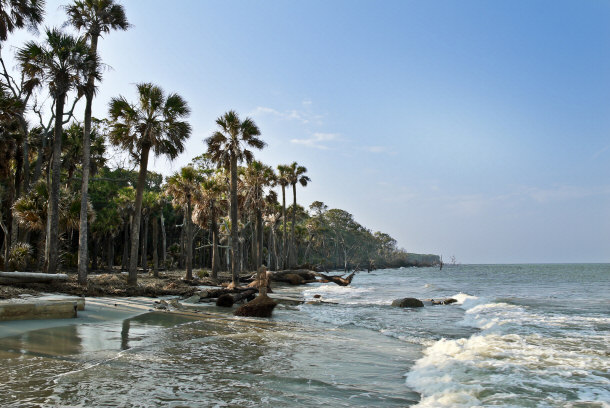
The most notable effect of the gravitational interplay between the planet and
its natural satellite is the loss of angular momentum and kinetic energy from
Earth's spin, which is transferred to the Moon. In layman's terms, this means
that the Earth is slowing down and the Moon is gradually changing its orbit.
However, before you start running for cover, the Moon's distances increases just
by 38mm each year, while the slowing down of the Earth's rotation results in a
lengthening of Earth's day on the order of 15 microseconds each year. Before
this effect ceases, resulting in a balance between the spin of the Earth and the
Moon's orbital period, the Sun will become a red giant, engulfing both. The
process will take millions of years, so you have plenty of time.
11) Only One Face Ever Shows
The tidal effects also have another interesting effect on the Moon's
relationship with Earth. If you look at the night sky, you can plainly see its
face. However, look at it several nights in a row and you'll clearly notice that
the Moon always shows the same face, no matter what. Is it stuck there or
something? The answer is fairly complex. This is the result of synchronous
rotation, where the Moon takes just as much time to rotate around its own axis
as it does to revolve around the Earth. As such, the Moon is rotating, but at
such a speed that at any given time only one face of it is directed towards the
Earth.
Which Face of the Moon Are You Seeing?
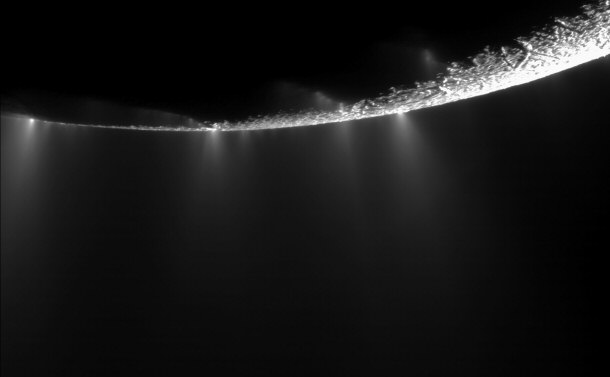
This interesting effect has other variations and can even be used to
stabilize some artificial satellites in Earth's orbit. A natural variation on
this is present in the case of Pluto and Charon. Although nominally the latter
is a moon of the former, the relationship between these two dwarf planets is
better characterized as binary. Pluto and Charon are locked in rotation with
each other, resulting in a unique setup. So, the next time you look at the sky,
don't worry; the Moon is rotating.
10) The Moon Isn't Bright
In general, looking at the Moon brings to mind the image of a bright disk
moving through the night sky, illuminating the Earth below. Without it, humanity
would surely be plunged into total darkness. However, the reality is, as usual,
quite a bit more complicated. While conventional wisdom would have the Moon's
surface be very bright, the actual reflectance of the surface is comparable to
coal and the color of rocks that make up its surface is a dull gray
transitioning to darker shades. The gray color is a result of the composition of
the surface, which is predominantly made up of oxygen, silicon, magnesium, iron,
calcium and aluminum. The monotony is varied up by rocks, which can be lighter
in color (plagioclase feldspar), darker (pyroxene), or even green (olivine).
Depending on the Time of Day and Location, Moon Light Can
Be Quite Bright
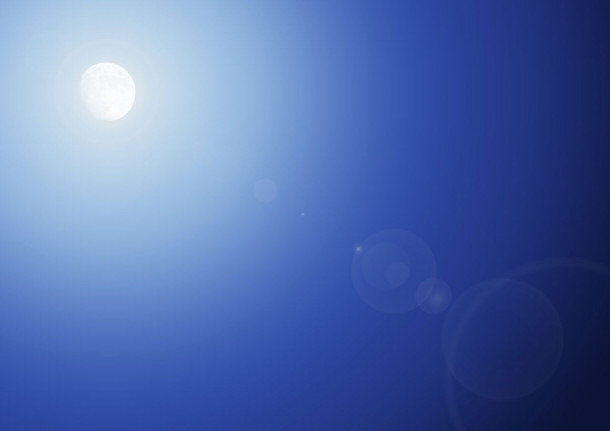
The darker patches on the Moon's face are the maria, or seas; named as such
by astronomers of old convinced that the Moon had standing water. These were
formed by volcanic eruptions on the planet surface and cover some 15 percent of
the Moon's surface. Interestingly, these are mostly located on the side of the
Moon facing Earth, with the far side of the Moon being home to thousands of
impact craters.
9) Moon Dust is Lethal
Of course, though these volcanic eruptions ceased millions of years ago, the
Moon remains dangerous. Perhaps the most insidious danger comes from the moon
dust peppering the surface of the satellite. Now, you may be thinking that moon
dust would be just like your garden variety sand: coarse and gritty, but not
dangerous, not seriously. Since the Moon has no atmosphere and running water, there is no way
for the dust on its surface to erode and become harmless. Moon dust has a
consistency of flour, a roughness similar to sandpaper, and toxicity comparable
to freshly fractured quartz and silica, both of which kill thousands of miners
each year through silicosis.
Apollo 11 Crew Training - Specifically Simulating Moon Dust
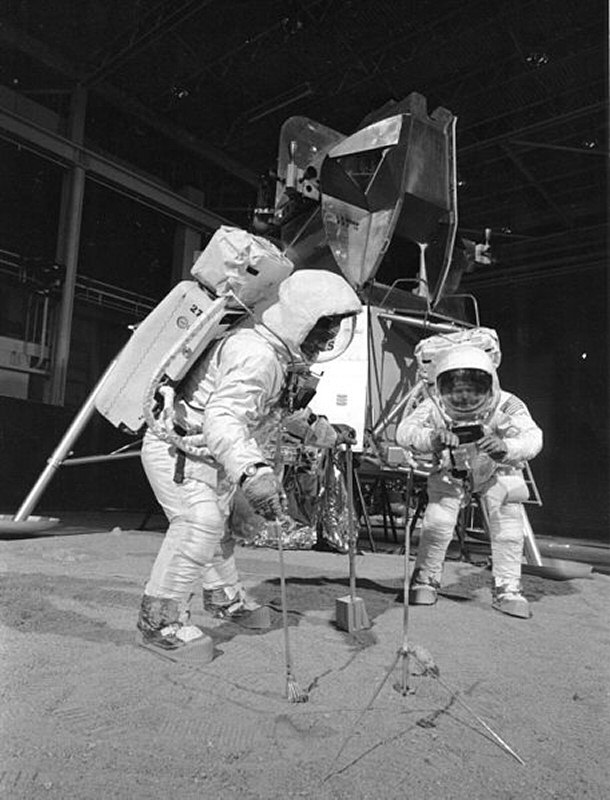
This became a practical problem for the last mission to the Moon in 1972,
when astronauts Jack Schmitt and Gene Cernan, due to a fender problem with the
Lunar Lander, were unable to prevent themselves from being showered with moon
dust while they worked on the surface. The dust proved persistent, chewing
through Kevlar reinforcing space suit joints and eventually finding its way to
the ship, where Schmitt inhaled it. Fortunately, it only resulted in a peculiar
form of hay fever, but this highlights the dangers that await future space
pioneers.
8) Humans Are Shooting the Moon with Lasers
While the heading may evoke images of Xerxes ordering the lashing of
Hellespont, the firing of lasers at the Moon is a fully scientific endeavor made
for a good reason. The Lunar Laser Ranging experiment is a research program that
started in 1962, when the Massachusetts Institute of Technology successfully
managed to use lasers to range the distance to the Moon. However, the program
really kicked into high gear when the first retroreflector arrays were placed on
the surface of the Moon by Apollo 11. The network was then expanded by
subsequent missions as well as the Soviet unmanned rovers, Lunokhods 1 and 2.
Lunokhods 2
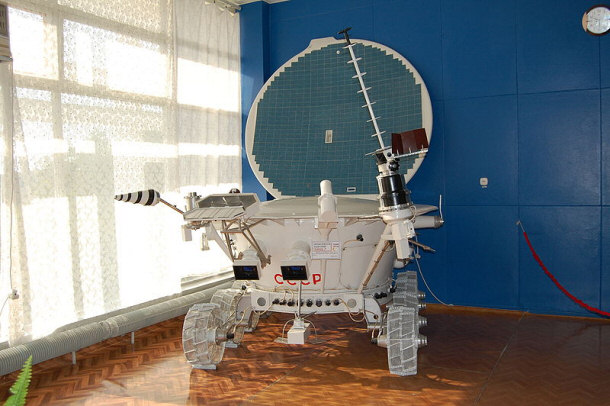
By Hayk (Own work),
via Wikimedia Commons
This experiment has allowed for an extremely precise ranging of the distance
of the Moon to the Earth, as well as verification of numerous scientific
hypotheses, including the aforementioned annual increases in the Moon's orbit,
verifying the probability of the Moon having a liquid core, as well as ruling
out the Nordtvedt effect, which would imply that the Earth and Moon are slowly
accelerating towards the Sun. It's an impressive achievement for a test that has
been compared by its authors to shooting a rifle at a moving coin three
kilometers away; out of all the photons fired at the Moon during a single
session, only one returns under favorable conditions.
7) It's a Limitless Source of Inspiration
Firing lasers at the Moon is an inspiring idea, just like the Moon itself.
The Earth's natural satellite has been an inspiration for human creativity since
ancient times. Lunar cycles were tied to pagan religions and their rituals,
while in some religions, the Moon itself was often considered to be a deity
complementing the Sun gods. But, of course, the influence of the Moon isn't
limited to just religion and related subjects. It is also one of the richest
sources of inspiration for writers and other creators.
The Moon is a Beautifully Wondrous Addition to the Night
Sky
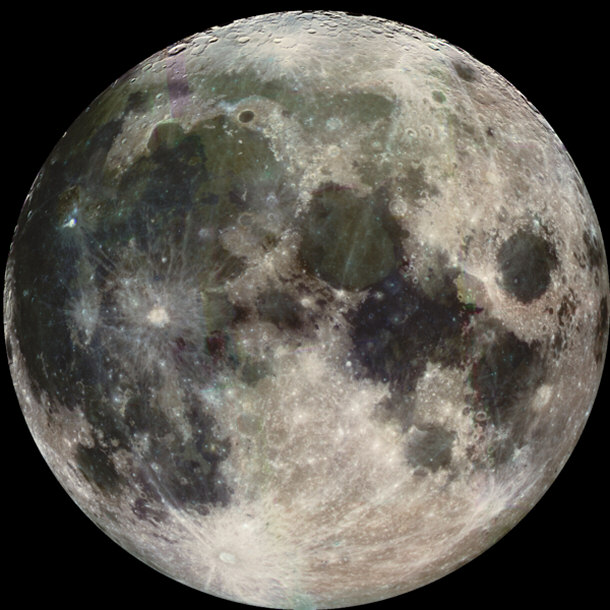
This is especially true of the science fiction genre, where the Moon plays a
vital role for Earth and its inhabitants. These portrayals can be dramatically
different, from Robert Heinlein's “The Moon is a Harsh Mistress”, where the
inhabitants of the lunar colonies declare independence from Earth, in order to
secure political and economic freedom for their unique society that formed among
the dangers of living on the Moon, to the Games Workshop “Warhammer 40,000”,
where it became a gigantic battle station protecting the throne world of the
Imperium of Man. The sky is truly the limit when it comes to the Moon in
fiction.
6) Some People Still Think the Landings Were a Hoax
Sometimes, the fiction is less strange than reality. Despite evidence to the
contrary, there still exists a sizable group of people that are convinced that
the Moon landings never happened and that the entire operation was faked in a
movie studio. These claims are often backed by various misinterpretations of
real data, such as photographs and other material from the lunar missions, or
not understanding the highly complex nature of space travel, especially
traveling to another celestial body.
The Moon Landings Did Happen - No Matter What Someone Might
Tell You
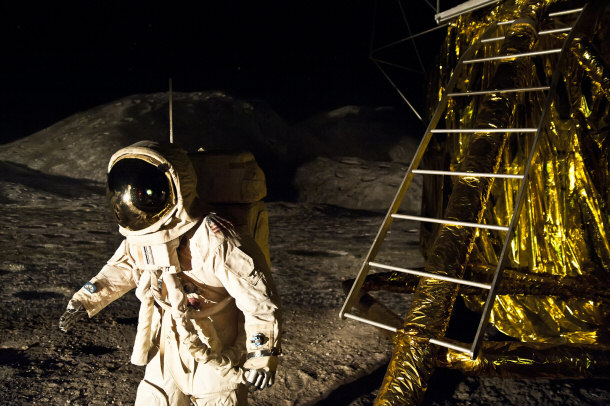
While reading the books and websites devoted to proselytizing the idea of the
Moon landing being a hoax can be amusing, it pays to remember that the claims of
the hoax movement have been thoroughly debunked. The latest hit to the hoax
theory comes from the Lunar Reconnaissance Orbiter mission, which transmitted
images of the original Apollo program landing sites in July 2009. Of course,
this isn't the only proof. There exist volumes of data related to tracking the
Apollo missions by various third parties, ranging from the Soviet Union to the
Kettering Grammar School in Northamptonshire. Of note is the reaction of Buzz
Aldrin to harassment by a hoaxer. After being relentlessly insulted, the
astronaut punched the conspiracy theorist in the jaw.
5) Only Twelve People Walked on the Moon
With the plethora of information available on the Moon, it might seem as if
humans have readily walked across the surface of the gray globe. However, the
reality is harsh, like the Moon. Manned landings on the Moon occurred during a
relatively short period between 1969 and 1972. The first landing, Apollo 11,
took place on July 20th, 1969. The first humans to walk on the surface of the
Moon were Neil Armstrong and Buzz Aldrin. The last were Gene Cernan and Jack
Schmitt, on December 14, 1972. Cernan was the last man on the Moon to date.
Neil Armstrong Pictured Placing American Flag During Apollo
11
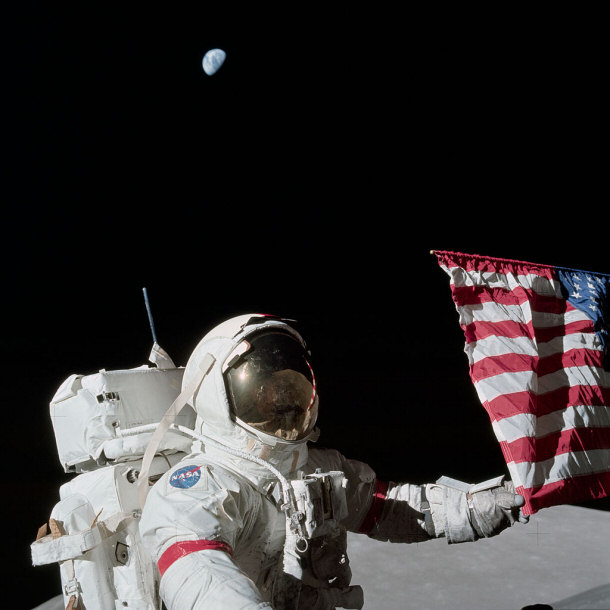
The missions to the Moon brought back tons of research information, from
shots and surveys, to samples of moon rock. Since then, the Moon has been
visited by unmanned spacecraft and probes, taking new photographs and gathering
further information on Earth's closest neighbor. The history of unmanned
landings is longer, beginning with the first successful landing in 1959,
performed by the Luna 2 spacecraft of the Soviet Union, followed by the United
States in 1962 with Ranger 4. It has to be noted that leaving the Moon, while
considerably easier than leaving Earth, is still a challenge with the current
level of technology.
4) The Moon Rocks are Priceless (and Controversial)
The manned missions to the Moon returned over 2,400 samples totaling nearly
400 kg worth of moon rock. Samples of the Moon's rock and soil are considered
priceless, for they are practically unavailable, except for rare lunar
meteorites that impact the Earth from time to time, and represent the apex of
human technological achievement in the 20th century. Research into lunar rocks
has yielded unique data providing insight into the Earth's moon. However, the
most fascinating element of the rocks is not so much their composition, but the
history surrounding them.
Moon Rocks At Johnson Space Center - Houston, TX
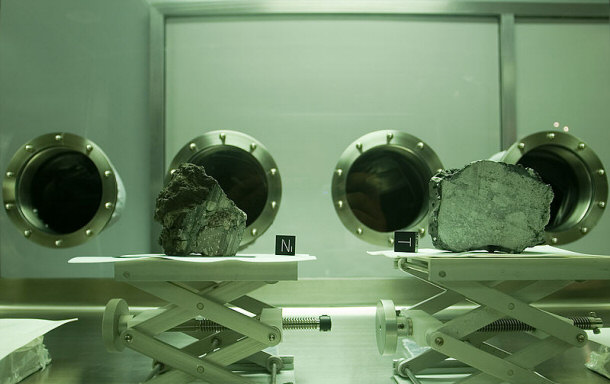
By Stuart Seeger (originally posted to Flickr as Moon Rocks),
via Wikimedia Commons
For example, the last lunar mission, Apollo 17, returned a particular lunar
rock to Earth, made up of different types of rock found on the Moon,
representing diversity. President Richard Nixon distributed fragments of this
rock to 135 foreign heads of state and the 50 U.S. states. The individual
Goodwill Moon rocks have a rich history. For example, the rocks gifted to Spain
under Franco are currently missing, lost by the Franco family. On American soil,
the bureaucracy of the state of Delaware has mishandled the reception of the
Goodwill rock to the point that no one, from the Governor to the Museum of
Natural History (its intended recipient), could tell where it might be.
3) Moon Treaty
However, political failures aren't limited to the national or state level. On
the international arena, perhaps the most spectacular failure is the Moon
Treaty, or the Agreement Governing the Activities of States on the Moon and
Other Celestial Bodies. The Moon Treaty was originally created in 1979 to give
jurisdiction of all celestial bodies and orbits to the international community,
embodied by the United Nations. Intended as an extension of the Outer Space
Treaty, this ambitious document would effectively make all extraterrestrial
territories international, banning all claims to sovereignty or possession.
Future Development Projects Are Governed By The Moon Treaty
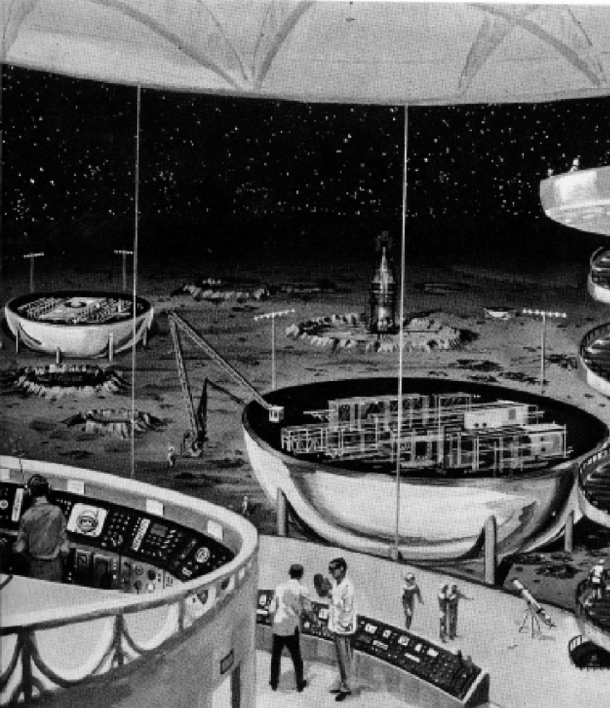
Since 1979, the ambitious Treaty has failed to gain any traction. In over
thirty years since its passing, only 15 states worldwide signed it. Practically
none of these states have a significant space program of their own. The largest
players, including the United States, Russian Federation, the European Space
Agency, Japan, China, and India have refused to sign the treaty. As such, it
remains a dead law, binding practically no one. It would be interesting to
consider the results of its ratification by the major space faring powers,
especially the implications of clauses explicitly forbidding contamination of
extraterrestrial bodies or the total ban on ownership of a celestial body,
unless it was by an international and governmental entity. As it is, the
conflicting political interests are likely to cause friction in future space
exploration and settlement of the Moon and nearby asteroids.
2) Colonizing the Moon is Going to Be Hard
While a colonized Moon is a long standing staple of science fiction, there
are many practical obstacles to it, which may overshadow the benefits. Sure, the
availability of construction material and favorable conditions for launching
spacecraft are undeniable advantages, as is its proximity to Earth, but the long
lunar nights and days are a consistent hazard. A bigger problem is the lack of
volatiles on the surface, including hydrogen and oxygen, which are necessary to
support a permanent settlement. Another problem is the availability of water,
which is a point of contention among scientists.
Artist Rendering of a Future Lunar Colony
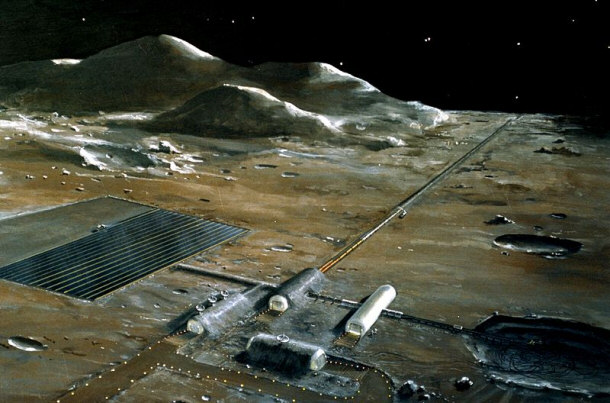
However, that's not all. The aforementioned low gravity is another concern,
as zero gravity has been confirmed to bring about detrimental changes in the
human body, leading to loss of bone and muscle muss, as well as devastation of
the immune system. Low gravity may reduce the severity of the symptoms or even
reduce them entirely, but this remains theoretical. Other hazards include the
lack of a substantial atmosphere protecting the colonists from cosmic radiation,
heat, micrometeoroids, and other dangers. Finally, the most basic problem is
that of providing food, as terrestrial plants can be problematic to adapt to an
environment with nearly year-long days and nights.
1) The Exact Origin of the Moon is Still Unknown
However, the most interesting fact about the Moon is that its origin remains
a great unknown. Although many hypotheses have been proposed, none of them have
been conclusively proven. The current leading hypothesis is the Giant Impact,
where a Mars-sized body (Theia) collided with Earth, creating a large debris
ring around the planet that would later form together to create the Moon. This
hypothesis is not without its own shortcomings. Theia would be expected to have
a different makeup and oxygen isotopic signature (unique to every celestial
body), resulting in a moon that's markedly different in composition from Earth.
However, the Moon is very close to Earth in terms of materials that make it up,
with a very close signature and element isotope ratios.
The Giant Impact Hypothesis Where the Moon Was A Free
Flying Astral Body and Collided With the Ancient Earth - The Earth's Gravity
Trapped The Moon
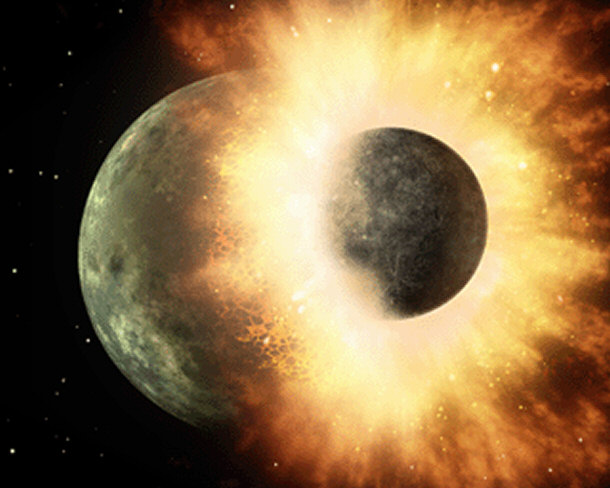
Other explanations have been proposed, including the Moon coalescing from
matter present in the solar system during its early evolution. Another
suggestion is that the Moon could be a small planet captured in Earth's orbit.
This hypothesis is largely ignored, as the aforementioned evidence of the
satellite being closely related to Earth renders it farfetched, at best.
However, the emergence of further evidence supporting the collision theory is
gradually eliminating competition in this field, leaving the Giant Impact as an
increasingly strong contender.
Final Words
The rich history of the Moon and the role it played in human history and
culture are among the most fascinating subjects to explore, regardless of
whether you're an astronomer or otherwise. Earth's only natural satellite still
holds many secrets that are just beginning to be uncovered. And until they are,
there is a wealth of knowledge to be gained, including both non-fiction and
fiction of all types.
More importantly, the Moon is bound to play a much bigger role in the future,
as one of the most important elements in humanity's climb to the stars.
Tentative plans for a return to the silver globe are being made, even though
they are put on hold due to temporary economic difficulties. However, humans
seem to be destined to reach for the stars, if not by will, then by need. As
Konstantin Tsiolkovsky, the father of modern rocketry said, a planet is the
cradle of mind, but one cannot live in a cradle forever.
Space
15 Ways Astronauts Live Differently on the ISS Than on Earth
Top 15 Fascinating Facts About the Moon
15 Fascinating Facts About Space Exploration |